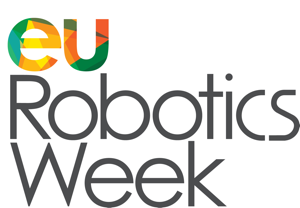This page is about 2013 event, which is now complete. For the 2014 STRANDS Robot Marathon please visit the 2014 page
In April 2013, our EU-funded STRANDS project started with the aim to develop autonomous mobile robots which are able to operate for long periods in everyday environments. When complete, these robots will perform intelligent tasks in care and security applications. Before that, we must ensure they can simply just survive without expert help in real world. To challenge ourselves and our robots, we decided to run a robot marathon during European Robotics Week 2013. This is an endurance competition in which the universities who are participating in the project run their robots for as long as possible, with the aim of them covering as much ground as possible.

The Competition
The competition started at 10.00am GMT / 11.00am CET on Novemeber 25th, and will close on November 29th 4.00pm GMT / 5.00pm CET.
Between these dates the STRANDS robots will attempt to run for as long as possible. If they get stuck they can ask for help from the people nearby. If they get low on battery then can charge themselves. If their expert handlers have to intervene to solve a problem, then their run must restart, resetting the distance and time accumulated.
Below you can see the current state of the competition. You can also follow our Twitter account for more updates, or search for the hashtag #RobotMarathon.
Best runs (distance and duration) for each robot
The following charts show the best runs for each robot. These are the runs for which each robot drove the furthest and kept going for the longest time.
All runs attempted this week
This chart shows the different runs each robot has attempted this week. A run ends when a robot has to be rescued from a difficult situation without first requesting help.
The Robots
Each of the six universities in the STRANDS project have a MetraLabs SCITOS A5 robot. Each one is competing in the marathon at their home university. You can find out more about each one from the links below. These links will also include live feeds from the robots' sensors where possible.
Background
Autonomous robots are robots which can make decisions for themselves. The majority of robots in use in the real world today are teleoperated, which means they are operated remotely by humans. Autonomous mobile robots have been researched by the robotics and artificial intelligence communities for many years, but few such robots have made it outside of the lab. The STRANDS project is dedicated to exploring both the technology required to enable such robots to leave the lab and work reliably in the real world. We are also researching the things such robots can learn once they're able to run for long periods in the real world. In the next few years we will deploy our robots in care and security applications in real industrial settings.
For more information on the STRANDS project please visit our homepage, follow us on Twitter, or contact the project coordinator, Nick Hawes.
You can also read media reports on the STRANDS project and related topcis from The Telegraph, BBC, and ITV.
You can find more about European Robotics Week here.
For an accessible introduction to the difficulties in creating autonomous robots, see the video below.






